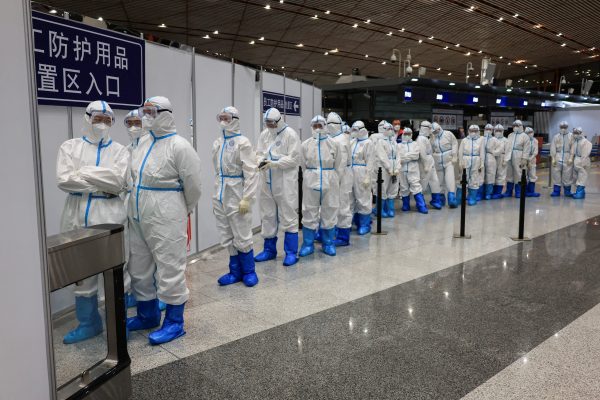This January the International Monetary Fund cut its 2022 growth forecast for China from 5.6 per cent to 4.8 per cent, citing ‘pandemic-induced disruptions related to the zero-tolerance COVID-19 policy’ as a primary factor. Eurasia Group listed China’s zero-COVID policy as its top risk for 2022.
But that zero-COVID policy is not going anywhere. Chinese leaders remain determined to prevent the spread of the virus. Chinese public health experts who advocate a removal of pandemic controls are still silent, censored, or made to walk back their arguments. In January 2022, in Shanxi Province, Xi acknowledged the challenge of ‘new mutant strains that spread quickly and are highly contagious’, but said officials ‘must always tighten the string of epidemic prevention and control, and persevere in making prevention the focus’.
Why does Beijing stick with this approach? The most important reason is that Xi has invested significant political capital in zero-COVID, which is portrayed as a shining example of how the Communist Party delivers good governance to the Chinese people. As Xi looks to secure a norm-defying third term as Chinese leader at the 20th Party Congress in the second half of 2022, he is focused on domestic stability and policy continuity while he manoeuvres to consolidate his power.
‘Living with COVID-19’ presents its own problems. Scholars from Peking University estimated that, if China adopted the ‘open-up’ strategies of Western governments, it could experience a ‘colossal outbreak’ with over 630,000 infections and 22,000 severe cases a day. Daily deaths would number in the hundreds or even the thousands. China is not a rich country and this caseload would overwhelm its public health system, causing public outcry and creating a political crisis for Xi’s leadership.
There’s a credible argument that the benefit to China’s economy of a zero-COVID strategy outweighs the drawbacks, at least for now. Surging cases, faltering health infrastructure and a wave of self-isolation in China could produce more acute labour shortages and supply chain disruptions than zero-COVID. In any case, there’s little chance that Xi will end his zero-COVID approach before the 20th Party Congress and any relaxation is likely to be cautious and gradual.
What would it take for Xi to change course? The upside scenario is that China rolls out homegrown mRNA vaccines by year’s end, as vaccine nationalism means Beijing refuses to approve foreign alternatives in mainland China — notwithstanding its recent willingness to approve Pfizer’s Paxlovid oral pill for Covid-19 patients with co-morbidities. The downside scenario is that wider lockdowns threaten a recession that brings graver political risk to Xi than COVID-19. But the bar appears high for such a move, as Xi has slowed the pace of signature policy agendas, such as common prosperity and financial deleveraging, to provide economic support for maintaining zero-COVID.
A top government epidemiologist recently hinted that officials were contemplating some tweaks to China’s pandemic containment policies, but there is little sign Beijing is preparing to allow domestic transmission of COVID-19 and it has so far managed to contain Omicron relatively well.
Something easy to miss from abroad is that it is far from clear if most Chinese people even want to abandon this stance. Social media posts and anecdotal reports indicate a creeping discontent yet the limited independent opinion polling published since 2020 suggests that China’s zero-COVID policy has coincided with stronger public support for the government.
Annual data for China in the 2022 Edelman Trust Barometer found that trust in government had increased by 9 per cent to 91 per cent and that trust in national health authorities had risen by 12 per cent to 93 per cent. These results resonate with a UC San Diego study from July 2020 that found urban Chinese citizens’ average trust in Beijing — as scored out of ten — grew from 8.23 in June 2019 to 8.87 in May 2020, with the share who ‘preferred living under China’s political system as compared to others’ climbing from 70 per cent to 83 per cent.
Popular support for zero-COVID could be another reason that Xi will persist with this policy for some time yet, especially considering the steep toll that such a reversal could take. A simple extrapolation from data for the United States — where COVID-19 has killed over 900,000 people in a population of 330 million — suggests that Xi’s zero-COVID policy may have prevented more than 4 million deaths among China’s 1.45 billion residents. This comparison is not scientific, but it gives a sense of the stakes for Xi.
Zero-COVID carries major economic risks for Beijing, but the hazards of ‘living with COVID-19’ mean that Beijing is unlikely to relax the policy until China is either safe or desperate. Xi can take heart from Taiwan, another zero-COVID jurisdiction, where President Tsai Ing-wen enjoys a plus-16 per cent net approval rating for her pandemic containment policies.
Neil Thomas is a China Analyst at Eurasia Group, a political risk advisory and consulting firm.

